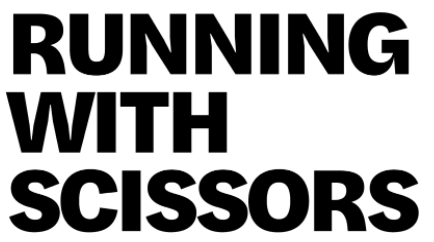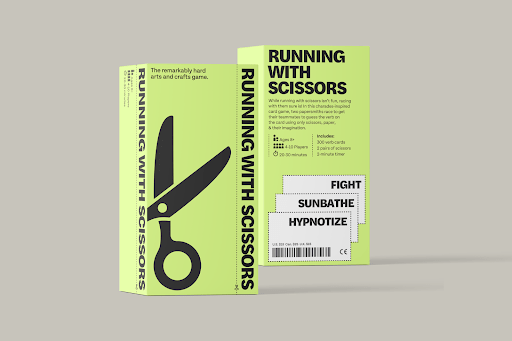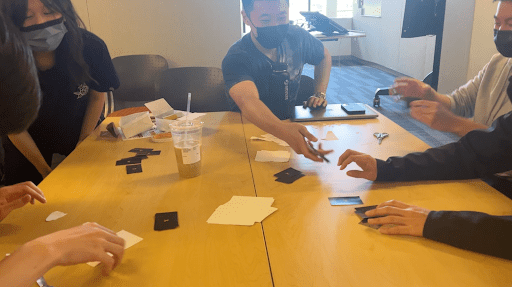
Christina Ding, Kevin Wang, & Will Osborn

ARTIST’S STATEMENT
Charades-inspired games are always a hit at game night, and we wanted to add our own twist to the genre by incorporating a deceptively difficult arts and crafts element! Running with Scissors is a team-based guessing activity where each turn, two representatives (Papersmiths) are chosen from the team and draw a card from our silly pile of verbs. They then have two minutes to cut out and animate paper in an attempt to get their teammates to guess the verb before the other team can do the same. We wanted our game to be low-stakes, facilitate lighthearted fun, and continuously engage each player regardless of whose turn it is. The team aspect also adds a dose of both camaraderie and healthy rivalry, keeping the energy high throughout the duration of the game.
CONCEPT SKETCH

INITIAL DECISIONS ABOUT FORMAL ELEMENTS
Formal Elements
Players: We decided to start with multilateral competition, where players compete to guess or cut as accurately as possible. Although the two types of roles (Papersmith and guesser) remained through multiple iterations, we tweaked how many Papersmiths and guessers there were (i.e. doing team competition rather than multilateral competition) to maximize engagement from all players.
Objectives: For the Papersmith, the objective is to cut paper to represent the word, while for the other players, their objective is to guess the word.
Outcomes: In each round, the guessers either guess the word correctly or not.
Resources: Keeping the game simple, we require only blank paper and a pair of scissors. We introduced a deck of verb cards shortly after as well.
Procedures: We wanted to keep the game simple, focusing on the core cutting and guessing element without too many additions. The initial procedure, for 3 players, was to pick a single Papersmith and guesser for each round, with another player coming up with the word for the Papersmith. The Papersmith would have a minute to cut shapes, and 15 seconds to move around and animate the paper shapes. After each round, the players would swap roles in a cycle.
Rules: To ensure the guessing was fair, the Papersmith is not allowed to verbally communicate or make charades-like gestures. The cutouts also could not be the word itself in letter format. However, we did allow moving paper in animations because that aligned with the crafts-like fun of our game. We decided not to allow using scrap paper at first, though later we changed this rule in order to reduce waste as well as to enrich the strategy of playing the game.
Boundaries: The game world is one in which, unlike the real world, the Playsmith and guessers are connected only by paper cutouts, and not by speech, gestures, or other communication methods. It is within this restricted realm of communication that we facilitate creative expression and play.
Types of fun
The game is a mix of social, challenge, and expression fun. The social fun involves interacting with other players though guessing and cutting, bringing out bewilderment, laughter, and excitement each round. The challenge-based fun occurs in both cutting and guessing. There is a sense of accomplishment for both the Papersmith and guesser once a word is correctly determined. Finally, there is expression-based fun for the Papersmith. It’s not often that we get to cut paper creatively like we did back in childhood, and this game is reminiscent of that simple creativity and expression.
PLAYTEST 0

Our first game was totally unrelated to Running with Scissors — it was actually a variation of Jenga, where each turn involved drawing a card and having to remove the block in a new way (e.g. remove a block with your eyes closed). We found that this game was not very exciting, perhaps because it was limited by the fun of Jenga itself. We found that the issue with our Jenga game is that the players waiting for their turn were not engaged. Furthermore, the intensity of fun was not high.
We pivoted. Inspired by social deduction games like Pictionary and A Fake Artist Goes to New York, we thought it would be fun to shape in 3D instead of only drawing in 2D. We considered using sculpting clay or similar materials, except we worried that the material would not last with repeated use. We considered instead Lego-like interlocking mechanisms as well. Instead, we decided to test with paper and scissors, which were readily available from our Jenga game cards. In a short playtest amongst ourselves, we found the cutting fun and challenging, and also discovered certain words (i.e. verbs) were conducive to animation.
PLAYTEST 01

With our basic concept of Pictionary with paper cutting in hand, we prototyped with external players. In this variation, only two players were playing at one time, with one player cutting and one guessing. Immediately, we found the game was fun. Players thoroughly enjoyed the struggle of having to cut out rough pieces of paper to illustrate complex concepts, and found an almost childlike joy in racing to cut out shapes as quickly as they could. We found two areas in need of change.
Limited engagement with pair format. The limited multilateral competition, with only one Papersmith and guesser playing at a time led to boredom for the other players, interaction between players that was limited to pairs, and a general lack of engagement. We knew we had to create a different type of competition and scoring system that would engage all players effectively.
Verbs are more fun than nouns. We noticed that word cards with verbs encourage players to animate the shapes they cut out on the table, while nouns cards led essentially to Pictionary but with paper cut-outs as the medium. We noticed that some players were wiggling around the pieces of paper, and that inspired us to lean heavily into verbs and encourage players to animate the shapes they cut out on the table.
PLAYTEST 02
Making use of the scrap pile. Our next playtest re-affirmed learnings from the previous playtest, as well as gave us the idea of using previous cutouts. We noticed that players naturally wanted to use cutouts that they had created in previous rounds. Allowing the use of the scrap pile led to reduced waste, and also deeper strategy because players could cut reusable shapes intentionally for future rounds.
Competition format was more engaging. We introduced a team-based format where one of two teams would go in each round. This meant more guessers were engaged, and there was a natural sense of competition between teams. However, many players from the non-playing team were still not engaged.
At the very end, switched to a competition format in which both teams played, racing to guess the same word. This was a hit! We had previously been struggling to establish a scoring system, so we knew we’d need to integrate the racing aspect into the final prototype.
PLAYTEST 03

Continuous draw mode: no-go. In this final playtest, we tested another competition method, in which both teams continuously drew cards instead of waiting to race round by round. However, this mode turned out to be logistically challenging. It also burned through cards super quickly. It did add some frantic energy that was enjoyable, but players stated that they felt more disconnected from the other team. In another context this might be a worthy trade-off, but since we’re trying to facilitate fellowship in a party setting it was a no-go.
Clarify rules. We were happy with the core mechanics, except we determined that there was still room for improvement. Notably, there was confusion around the rules. The Papersmith concept was confusing and the rules around animation needed to be much more explicit. It wasn’t clear that both would be looking at the same card and racing to represent the same verb to their respective teams.
Bump up the difficulty. We also found that the game went much faster than expected. Especially when using the scrap pile, teams were able to get each word in 10-20 seconds after a few rounds, rather than the minute we originally expected. As players intuited that all cards were verbs, they were able to guess verbs accurately. We decided we needed to increase the difficulty and variation in the word cards, as well as increase the points ceiling.
FINAL PROTOTYPE
Running With Scissors – Print & Play
MOCKUPS




